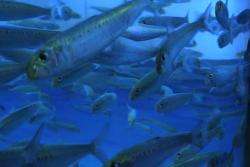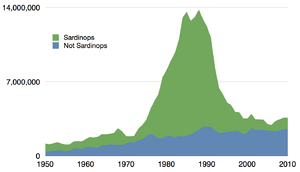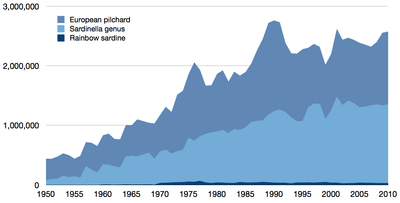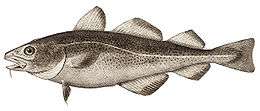Sardine
.jpg)
"Sardine" and "pilchard" are common names used to refer to various small, oily fish within the herring family of Clupeidae.[2] The term sardine was first used in English during the early 15th century and may come from the Mediterranean island of Sardinia, around which sardines were once abundant.[3][4]
The terms "sardine" and "pilchard" are not precise, and what is meant depends on the region. The United Kingdom's Sea Fish Industry Authority, for example, classifies sardines as young pilchards.[5] One criterion suggests fish shorter in length than 15 cm (6 in) are sardines, and larger fish are pilchards.[6] The FAO/WHO Codex standard for canned sardines cites 21 species that may be classed as sardines;[7] FishBase, a comprehensive database of information about fish, calls at least six species "pilchard", over a dozen just "sardine", and many more with the two basic names qualified by various adjectives.
Genera
Sardines occur in several genera
- Genus Dussumieria
- Rainbow sardine (Dussumieria acuta)
- Slender rainbow sardine (Dussumieria elopsoides)
- Genus Escualosa
- Slender white sardine (Escualosa elongata)
- White sardine (Escualosa thoracata)
- Genus Sardina
- European pilchard (true sardine) (Sardina pilchardus)
- Genus Sardinella
- Goldstripe sardinella (Sardinella gibbosa)
- Indian oil sardine (Sardinella longiceps)
- Round sardinella (Sardinella aurita)
- Genus Sardinops
- South American pilchard (Sardinops sagax)
Species
| This article is one of a series on |
| Commercial fish |
|---|
| |
| Large pelagic |
| billfish, bonito mackerel, salmon shark, tuna |
|
|
| Forage |
| anchovy, herring menhaden, sardine shad, sprat |
|
|
| Demersal |
| cod, eel, flatfish pollock, ray |
| Mixed |
| carp, tilapia |
| Commercially significant species | ||||||||||||||
|---|---|---|---|---|---|---|---|---|---|---|---|---|---|---|
| Genus | Common name | Scientific name | Max. length | Common length | Max. mass | Max. age years |
Trophic level |
Fish Base |
FAO | ITIS | IUCN status | |||
| cm | in | cm | in | g | oz | |||||||||
| Sardina | European pilchard* | Sardina pilchardus (Walbaum, 1792) | 27.5 | 10.8 | 20.0 | 7.9 | 15 | 3.05 | [8] | [9] | [10] | |||
| Sardinops | South American pilchard | Sardinops sagax (Jenyns, 1842) | 39.5 | 15.6 | 20.0 | 7.9 | 490 | 17 | 25 | 2.43 | [11] | [12] | [13] | |
| Japanese pilchard[note 1] | Sardinops melanostictus (Schlegel, 1846) | [15] | [16] | [17] | ||||||||||
| Californian pilchard[note 1] | Sardinops caeruleus (Girard, 1854) | [18] | [19] | [20] | ||||||||||
| southern African pilchard[note 1] | Sardinops ocellatus (Pappe, 1854) | [21] | [22] | [23] | ||||||||||
| Sardinella | Bali sardinella | Sardinella lemuru (Bleeker, 1853) | 23 | 9.1 | 20 | 7.9 | [24] | [25] | [26] | |||||
| Brazilian sardinella | Sardinella brasiliensis (Steindachner, 1879) | 3.10 | [27] | [28] | [29] | |||||||||
| Japanese sardinella | Sardinella zunasi (Bleeker, 1854) | 3.12 | [30] | [31] | [32] | |||||||||
| Indian oil sardine | Sardinella longiceps (Valenciennes, 1847) | 2.41 | [33] | [34] | [35] | [36] | ||||||||
| Goldstripe sardinella | Sardinella gibbosa (Bleeker, 1849) | 2.85 | [37] | [38] | [39] | |||||||||
| Round sardinella | Sardinella aurita (Valenciennes, 1847) | 3.40 | [40] | [41] | [42] | |||||||||
| Madeiran sardinella | Sardinella maderensis (Lowe, 1839) | 3.20 | [43] | [44] | [45] | |||||||||
| Dussumieria | Rainbow sardine | Dussumieria acuta (Valenciennes, 1847) | 20 | 7.9 | 3.40 | [46] | [47] | [48] | ||||||


Feeding
Sardines feed almost exclusively on zooplankton, "animal plankton", and will congregate wherever this is abundant.
Fisheries
Typically, sardines are caught with encircling nets, particularly purse seines. Many modifications of encircling nets are used, including traps or weirs. The latter are stationary enclosures composed of stakes into which schools of sardines are diverted as they swim along the coast. The fish are caught mainly at night, when they approach the surface to feed on plankton. After harvesting, the fish are submerged in brine while they are transported to shore.
Sardines are commercially fished for a variety of uses: for bait; for immediate consumption; for drying, salting, or smoking; and for reduction into fish meal or oil. The chief use of sardines is for human consumption, but fish meal is used as animal feed, while sardine oil has many uses, including the manufacture of paint, varnish and linoleum.
As food
Sardines are commonly consumed by human beings. Fresh sardines are often grilled, pickled or smoked, or preserved in cans.
Sardines are rich in vitamins and minerals. A small serving of sardines once a day can provide 13 percent of vitamin B2; roughly one-quarter of niacin; and about 150 percent of the recommended daily value of vitamin B12. All B vitamins help to support proper nervous system function and are used for energy metabolism, or converting food into energy.[49] Also, sardines are high in the major minerals such as phosphorus, calcium, potassium, and some trace minerals including iron and selenium. Sardines are also a natural source of marine omega-3 fatty acids, which may reduce the occurrence of cardiovascular disease.[50] Recent studies suggest that regular consumption of omega-3 fatty acids reduces the likelihood of developing Alzheimer's disease.[51] These fatty acids can also lower blood sugar levels.[52] They are also a good source of vitamin D,[53] calcium, vitamin B12,[54][55] and protein.
Because they are low in the food chain, sardines are very low in contaminants such as mercury, relative to other fish commonly eaten by humans.[56]
History

Pilchard fishing and processing became a thriving industry in Cornwall (UK) from around 1750 to around 1880, after which it went into decline. Catches varied from year to year and, in 1871 the catch was 47,000 hogsheads while in 1877 only 9,477 hogsheads. A hogshead contained 2,300 to 4,000 pilchards and, when filled with pressed pilchards, weighed 476 lbs. The pilchards were mostly exported to Roman Catholic countries such as Italy and Spain where they are known as ″fermades″. The chief market for the oil was Bristol where it is used on machinery.[57] As of 2007, however, stocks are improving .[58] Since 1997, sardines from Cornwall have been sold as "Cornish sardines", and since March 2010, under EU law, Cornish sardines have Protected Geographical Status.[59] The industry has featured in numerous works of art, particularly by Stanhope Forbes and other Newlyn School artists.
In the United States, the sardine canning industry peaked in the 1950s. Since then, the industry has been on the decline. The canneries in Monterey Bay, in what was known as Cannery Row, failed in the mid-1950s. The last large sardine cannery in the United States, the Stinson Seafood plant in Prospect Harbor, Maine, closed its doors on 15 April 2010 after 135 years in operation.[60]
The traditional "Toast to Pilchards" refers to the lucrative export of the fish to Catholic Europe:
- Here's health to the Pope, may he live to repent
- And add just six months to the term of his Lent
- And tell all his vassals from Rome to the Poles,
- There's nothing like pilchards for saving their souls![61]
In popular culture
The close packing of sardines in the can has led to the metaphorical use of their name in describing any situation where people or objects are crowded together, for instance, in a bus or subway car. This phenomenon is satirised by British poet and comic Spike Milligan in his poem 'Sardine Submarine'. In the poem, a sardine's mother describes the unfamiliar sight of a submarine to its offspring as 'a tin full of people'.[62]
'Sardines' is also the name of a children's game, where one person hides and each successive person who finds the hidden one packs into the same space until there is only one left out, who becomes the next one to hide.[63]
See also
Notes
- 1 2 3 Based on data sourced from the relevant FAO Species Fact Sheets
- ↑ "What's an oily fish?". Food Standards Agency. 24 June 2004.
- ↑ Sardine Online Etymology Dictionary. Retrieved 15 April 2012.
- ↑ "Sardine". The Good Food Glossary. BBC Worldwide. 2009. Retrieved 1 November 2009.
- ↑ "FAQs". Seafish. Retrieved 22 February 2010.
- ↑ Robin Stummer (17 August 2003). "Who are you calling pilchard? It's 'Cornish sardine' to you...". The Independent. Retrieved 1 November 2009.
- ↑ "Codex standard for canned sardines and sardine-type products codex stan 94 –1981 REV. 1–1995" (PDF). Codex Alimentarius. FAO/WHO Codex Alimentarius Commission. pp. 1–7. Retrieved 18 January 2007.
- ↑ Froese, Rainer and Pauly, Daniel, eds. (2012). "Sardina pilchardus" in FishBase. April 2012 version.
- ↑ Sardina pilchardus (Walbaum, 1792) FAO, Species Fact Sheet. Retrieved April 2012.
- ↑ "Sardina pilchardus". Integrated Taxonomic Information System. Retrieved April 2012. Check date values in:
|access-date=(help) - ↑ Froese, Rainer and Pauly, Daniel, eds. (2012). "Sardinops sagax" in FishBase. April 2012 version.
- ↑ Sardinops sagax (Jenyns, 1842) FAO, Species Fact Sheet. Retrieved April 2012.
- ↑ "Sardinops sagax". Integrated Taxonomic Information System. Retrieved April 2012. Check date values in:
|access-date=(help) - ↑ Grant, W. S.; et al. (1998). "Why restriction fragment length polymorphism analysis of mitochondrial DNA failed to resolve sardine (Sardinops) biogeography: insights from mitochondrial DNA cytochrome b sequences". Canadian Journal of Fisheries and Aquatic Sciences. 55 (12): 2539–47. doi:10.1139/f98-127.
- ↑ Froese, Rainer and Pauly, Daniel, eds. (2012). "Sardinops melanostictus" in FishBase. April 2012 version.
- ↑ Sardinops melanostictus (Schlegel, 1846) FAO, Species Fact Sheet. Retrieved April 2012.
- ↑ "Sardinops melanostictus". Integrated Taxonomic Information System. Retrieved April 2012. Check date values in:
|access-date=(help) - ↑ Froese, Rainer and Pauly, Daniel, eds. (2012). "Sardinops caeruleus" in FishBase. April 2012 version.
- ↑ Sardinops caeruleus (Girard, 1854) FAO, Species Fact Sheet. Retrieved April 2012.
- ↑ "Sardinops caeruleus". Integrated Taxonomic Information System. Retrieved April 2012. Check date values in:
|access-date=(help) - ↑ Froese, Rainer and Pauly, Daniel, eds. (2012). "Sardinops ocellatus" in FishBase. April 2012 version.
- ↑ Sardinops ocellatus (Pappe, 1854) FAO, Species Fact Sheet. Retrieved April 2012.
- ↑ "Sardinops ocellatus". Integrated Taxonomic Information System. Retrieved April 2012. Check date values in:
|access-date=(help) - ↑ Froese, Rainer and Pauly, Daniel, eds. (2012). "Sardinella lemuru" in FishBase. April 2012 version.
- ↑ Sardinella lemuru (Bleeker, 1853) FAO, Species Fact Sheet. Retrieved April 2012.
- ↑ "Sardinella lemuru". Integrated Taxonomic Information System. Retrieved April 2012. Check date values in:
|access-date=(help) - ↑ Froese, Rainer and Pauly, Daniel, eds. (2012). "Sardinella brasiliensis" in FishBase. April 2012 version.
- ↑ Sardinella brasiliensis (Steindachner, 1879) FAO, Species Fact Sheet. Retrieved April 2012.
- ↑ "Sardinella brasiliensis". Integrated Taxonomic Information System. Retrieved April 2012. Check date values in:
|access-date=(help) - ↑ Froese, Rainer and Pauly, Daniel, eds. (2012). "Sardinella zunasi" in FishBase. April 2012 version.
- ↑ Sardinella zunasi (Bleeker, 1854) FAO, Species Fact Sheet. Retrieved April 2012.
- ↑ "Sardinella zunasi". Integrated Taxonomic Information System. Retrieved April 2012. Check date values in:
|access-date=(help) - ↑ Froese, Rainer and Pauly, Daniel, eds. (2012). "Sardinella longiceps" in FishBase. April 2012 version.
- ↑ Sardinella longiceps (Valenciennes, 1847) FAO, Species Fact Sheet. Retrieved April 2012.
- ↑ "Sardinella longiceps". Integrated Taxonomic Information System. Retrieved April 2012. Check date values in:
|access-date=(help) - ↑ Munroe TA & Priede IG (2010). "Sardinella longiceps". IUCN Red List of Threatened Species. Version 2011.2. International Union for Conservation of Nature. Retrieved April 2012. Check date values in:
|access-date=(help) - ↑ Froese, Rainer and Pauly, Daniel, eds. (2012). "Sardinella gibbosa" in FishBase. April 2012 version.
- ↑ Sardinella gibbosa (Bleeker, 1849) FAO, Species Fact Sheet. Retrieved April 2012.
- ↑ "Sardinella gibbosa". Integrated Taxonomic Information System. Retrieved April 2012. Check date values in:
|access-date=(help) - ↑ Froese, Rainer and Pauly, Daniel, eds. (2012). "Sardinella aurita" in FishBase. April 2012 version.
- ↑ Sardinella aurita (Valenciennes, 1847) FAO, Species Fact Sheet. Retrieved April 2012.
- ↑ "Sardinella aurita". Integrated Taxonomic Information System. Retrieved April 2012. Check date values in:
|access-date=(help) - ↑ Froese, Rainer and Pauly, Daniel, eds. (2012). "Sardinella maderensis" in FishBase. April 2012 version.
- ↑ Sardinella maderensis (Lowe, 1839) FAO, Species Fact Sheet. Retrieved April 2012.
- ↑ "Sardinella maderensis". Integrated Taxonomic Information System. Retrieved April 2012. Check date values in:
|access-date=(help) - ↑ Froese, Rainer and Pauly, Daniel, eds. (2012). "Dussumieria acuta" in FishBase. April 2012 version.
- ↑ Dussumieria acuta (Valenciennes, 1847) FAO, Species Fact Sheet. Retrieved April 2012.
- ↑ "Dussumieria acuta". Integrated Taxonomic Information System. Retrieved April 2012. Check date values in:
|access-date=(help) - ↑ Retrieved 22 February 2012
- ↑ Kris-Etherton; Harris, WS; Appel, LJ; American Heart Association. Nutrition Committee; et al. (November 2002). "Fish Consumption, Fish Oil, Omega-3 Fatty Acids, and Cardiovascular Disease". Circulation. 106 (21): 2747–2757. doi:10.1161/01.CIR.0000038493.65177.94. PMID 12438303.
- ↑ Sharon Johnson (6 November 2007). "Oily brain food ... Yum". The Mail Tribune. Retrieved 1 November 2009.
- ↑ "Omega-3 fatty acids, fish oil, alpha-linolenic acid: MedlinePlus Supplements". Retrieved 22 January 2010.
Fish oil supplements may lower blood sugar levels a small amount. Caution is advised when using herbs or supplements that may also lower blood sugar. Blood glucose levels may require monitoring, and doses may need adjustment.
- ↑ "Vitamin D and Healthy Bones". New York State Health Department. November 2003. Retrieved 1 November 2009.
- ↑ "Vitamin B12". George Mateljan Foundation. Retrieved 11 April 2012.
- ↑ "Vitamin B12". EatingWell. Retrieved 11 April 2012.
- ↑ "Mercury Levels in Commercial Fish and Shellfish". U S Food and Drug Administration. 5 July 2009. Retrieved 1 November 2009.
- ↑ Buckland, Frank (26 February 1880). "Our Fisheries". The Cornishman (85). p. 6.
- ↑ River Cottage: Gone Fishing 22/11/08
- ↑ EU Directory of PGI/PDO/TSG – Cornish Sardines profile (accessed 1/11/2010)
- ↑ Clarke Canfield (15 April 2010). "Last sardine plant in U.S. shuts its doors". Associated Press. Retrieved 15 April 2010.
- ↑ Traditional Cornish Stories and Rhymes, 1992 edition, Lodenek Press
- ↑ "Even more Spike Milligan side-splitters" Tostevin.net (2012-07-13). Retrieved 2014-02-12.
- ↑ "Stinky Sardine Club – ITPedia". Itpedia.nyu.edu. 9 April 2010. Retrieved 21 June 2012.
References
- Parrish, R. H.; et al. (1989). "The monotypic sardines, Sardina and Sardinops: Their taxonomy, distribution, stock structure, and zoogeography" (PDF). Can.J.Fish.Aquar.Sci. 46: 2019–36. doi:10.1139/f89-251.
External links
| Wikimedia Commons has media related to Sardines. |




.png)
